1917, July: The Cottingley Fairies
| Hi, folks! Please be aware that this is one of the earliest articles added to Anomalies; since that time, I've gotten both better at researching and more picky about my information, so am working on a more informative re-write of this article... in the meantime, Enjoy! |
In July 1917, 16-year-old Elsie Wright and her 10-year-old cousin Frances Griffiths were tired of being chided by Elsie's father over their claims of seeing fairies... so they took a photograph of some to prove their existence.
The girls lived together in Cottingley, on the outskirts of Bradford, West Yorkshire, England. They often played together in the small wooded creek behind Elsie's home, and this is where they saw the fairies. On a day in July, Elsie, tired of her father's dismissive attitude to her and Frances' claims, borrowed her father's camera to take a picture. When the film was developed later in her father's dark room, Elsie's parents were in for a surprise; the picture that she had taken was of Frances... with a troop of fairies dancing in front of her.
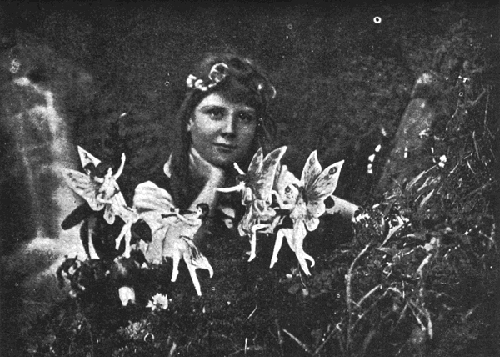
Elsie's parents were flabbergasted; but her father wasn't convinced. So, a month later, Frances took a picture of Elsie which clearly showed her playing with a gnome.
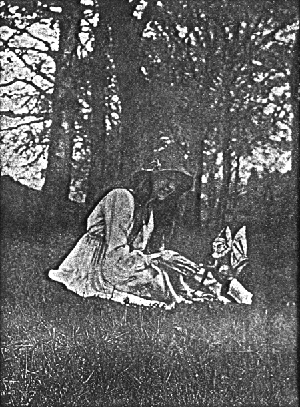
Mr. Wright still wasn't convinced, and there the matter settled. The girls showed the pictures to their friends, but no particular interest was ever raised by them... at least, not until two years had passed.
Elsie's mother had developed an interest in things supernatural, and took the pictures to share with a Theosophist meeting in Bradford one evening. In no time at all, the pictures were the center of attention and argument. Of the people who believed the fairies were real, the most prominent and vocal was Sir Arthur Conan Doyle, creator of Sherlock Holmes. Sir Arthur printed the first two pictures in Strand Magazine in 1920 to help support his argument for the existence of fairies; this article made the story a worldwide sensation.
In 1920, Sir Arthur arranged for Elsie and Frances to once again be given a camera and left on their own in the small creek. The results were three more photos of the fairies; the last to be made, for shortly after this photo session Elsie and Frances moved away from one another and stopped seeing fairies. Sir Arthur later printed these three pictures in a sequel to his earlier article, and, in 1922, he expanded the two articles into a book, The Coming of the Fairies.


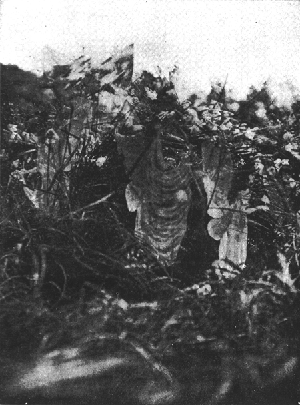
The Rest of the Story
While the legend of the Cottingley Fairies as told in a number of popular magazines and children's books over the years may end as the account above does, there is some more to be added to the situation now.
The controversy over the pictures continued to rage into the 1960's, when new techniques for examining the photos brought them more into question. Elsie's position on the matter became vague. In 1966 she was quoted as saying she had photographed "figments of my imagination," and in 1971 on BBC TV in England she said that she just wanted to leave the subject "open." In 1976 during an YTV 'Calendar' interview, Frances (now 69) and Elsie (now 75) were asked, "Did you in any way fabricate those photographs?" Elsie answered firmly: "Of course not." Frances' answer was interesting: "You tell us how she could do it... and then we'll tell you. ... Remember, she was sixteen. And I was ten."
In 1982, Geoffrey Crawley, then the editor of the British Journal of Photography, published an article detailing his examination of what was believed to be the original negatives of the Cottingley photographs in the Brotherton Collection of Leeds University. His argument was simple; the 'Midg' style camera that was used by the girls to take the first two photographs was, by design, incapable of producing negatives as clearly defined as the negatives that were in the Brotherton Collection. Amazingly, he managed to find what appears to be an original print of the first photo in Cottingley; a comparison of this original to a print made from the Brotherton negatives is startling.
The original is muddy and fuzzy; Frances face can just be made out, and the "fairies" are just splotches of white -- and, as Crawley said, "...exactly the type of, shall we say, less lively image that you would expect from a camera of this type." A closer examination of the negatives in the Brotherton Collection revealed evidence of airbrush retouching to make the fairies more defined, and of burnishing to help drop Frances' face into the background. Therefore, the popular version of the photos that was being presented in the press and books were fradulent.
In an article in the Times of London for March 18, 1983, 76-year-old Frances Griffiths admitted the first four pictures were faked; now 82-year-old Elsie Wright Hill at first refused to comment, but in a second article on April 4 she confirmed the hoax. They had cut out figures drawn on bristol board by Elsie, and stood them up with hat-pins. The fairies in the first photo were traced from an illustration of dancing girls that came from page 104 of a copy of Princess Mary's Gift Book.
But the two disagreed on the fifth picture; mainly each woman claimed to have been the one to take it. Frances stated that it was the only genuine photo, and Elsie claimed "it was all done with my own contraption and I had to wait for the weather to be right to take it."
This last seeming controversy was quickly given a logical explaination by none other than Geoffrey Crawley. In a letter to the Times on April 9, 1983, Crawley pointed out the the fifth and last photo, called "Fairies and Their Sun-Bath" by Sir Arthur, was previously studied in 1972 by Brian Coe, Curator of the Kodak Museum. Coe concluded it was a double exposure of fairy cutouts in grass, which explains why both women were convinced they had taken the photo... both had.
In Their Own Words
I am hunting both for a copy of the Strand Magazines with Sir Arthur's fairy articles and for a copy of the British Journal of Photography with Geoffrey Crawley's examination of the photos. I do, however, have a copy of Sir Arthur Conan Doyle's book on the affair, The Coming of the Fairies (the copies of the five Cottingley photos in this article are from it), and I will slowly be adding the information from that text to this article. For now though, I would like to just give Sir Arthur's impressions of the photos, as is included with each within the book.
Picture 1: Frances and the Dancing Fairies
"This original negative is asserted by expert photographers to bear not the slightest trace of combination work, retouching, or anything whatever to mark it as other than a perfectly straight single-exposure photograph, taken in the open air under natural conditions."
As Geoffrey Crawley clearly showed in Arthur C. Clarkes World of Strange Powers, the negative that is presented in Sir Arthur's book has very obviously been touched up, though it is very unlikely Sir Arthur knew that.
Picture 2: Elsie and the Gnome
"The original negative has been tested, enlarged, and analysed in the same exhaustive manner as A. [picture 1]"
Picture 3: Frances and the Leaping Fairy, Picture 4: Fairy offering Posy of Hare-Bells to Elsie, & Picture 5: Fairies and their Sun-Bath
"This negative [picture 3] and the two following have been as strictly examined as the earlier ones, and similiarly disclose no trace of being other than perfectly genuine photographs. Also they have proved to have been taken from the packet given them, each plate having been privately marked unknown to the girls."
Here Sir Arthur shows enough sense to protect against the possibility of being handed a different packet of film by the girls, but still doesn't consider the possibility of simple trick photography on the youngsters' part. It proved a useless measure to mark the pack of film since the girls were then left alone to take the photos.
Theories
At the height of the controversy, many small problems were noticed in the pictures... ironically, these became arguments both for and against the authenticity of the photos. For instance, in the picture of Elsie with the gnome (the second picture), Elsie pointed out that you can see the head of the hat-pin poking out of the gnome's chest. Sir Arthur Conan Doyle saw it too... and explained it as evidence of a fairy navel, and took it as evidence that fairies reproduce in the same way as humans do.
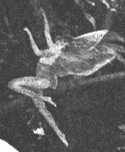
In the picture of Frances with the leaping fairy (the third picture), it was pointed out that the fairy's farthest leg does not logically connect to the body, a problem easily explained when Elsie admitted she had drawn it wrong. But, at the time, the problem was heralded as proof that they actually were pictures of fairies... the logic was that since fairies are etherial creatures, the misplaced leg was proof that the body was a temporary creation (this despite the importance Sir Arthur attached to the gnome's "belly-button").
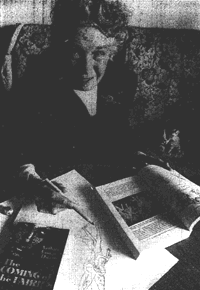
It was noticed early on that the fairies looked oddly two-dimensional and in focus when compared with Elsie and Frances. It was also noted as strange that the fairies had very modern hairstyles. According to Jenny Randles in Strange & Unexplained Mysteries of the 20th Century, Elsie had worked for a photographer for some months; and according to the Times of London article from April 4, 1983, Elsie was earning money by coloring sepia photographs of soldiers fighting in the first World War that was still raging at the time. Hoax was also a suspicion because of the fact that the girls were only able to produce the photos when left alone. Unfortunately, this fact was defended by believers as an obvious necessity, since the fairies only trusted the girls.
Many believers argued that the fairies could be seen to be moving within the pictures; in 1984, Elsie Wright explained away this apparent proof: "...they said that ... they could see them, that the fairies were moving when the photographs were taken; but that's because they [the paper cutouts] did it [moved] in the breeze." [quoted from Arthur C. Clarke's World of Strange Powers.]
In his letter to the Times on April 9, 1983, Geoffrey Crawley states that the pictures were dismissed as fakes back in 1920 by the photographic technologists of Kodak... this announcement was followed by all access to the pictures being barred by Edward L. Gardner and, later, his son. In fact, according to Arthur C. Clarke's World of Strange Powers, Geoffrey Crawley suspects that the original photos were retouched by Gardner, who was a friend of Sir Arthur Conan Doyle, a believer in fairies, and the national secretary of the Theosophical Society; but in his letter to the Times on April 9, 1983, Crawley clearly points a finger instead at H. Snelling, a darkroom technician who made and sold prints of the photos.
Anomalies -- the Strange & Unexplained, as well as my other website -- Monsters Here & There -- are supported by patrons, people like you! All new Anomalies articles are now posted for my patrons only, along with exclusive content made just for them. You can become a patron for just $1 a month!
|








